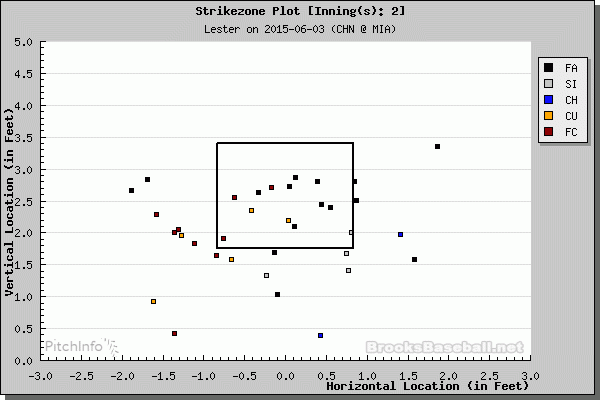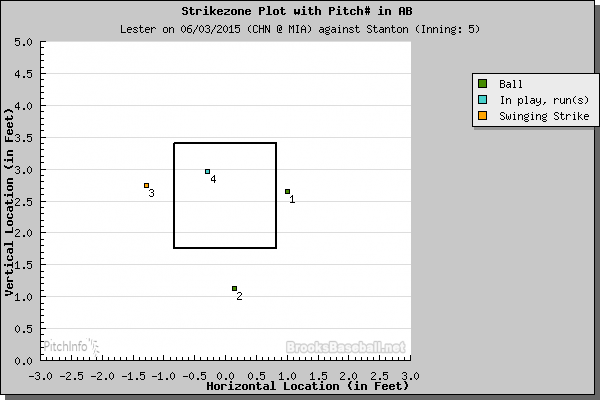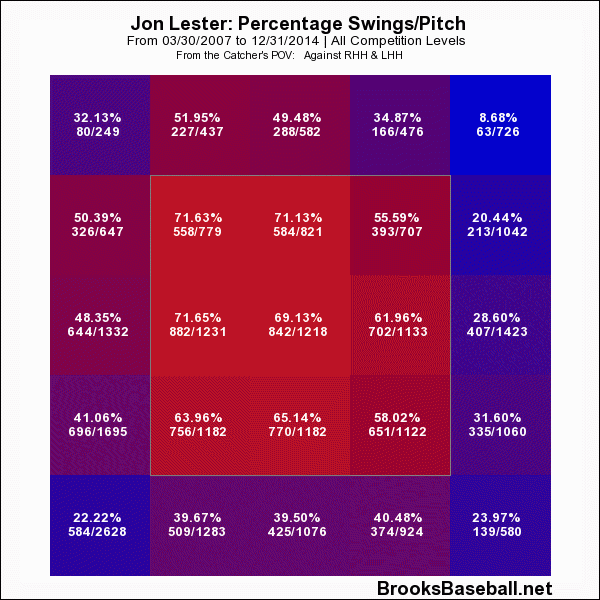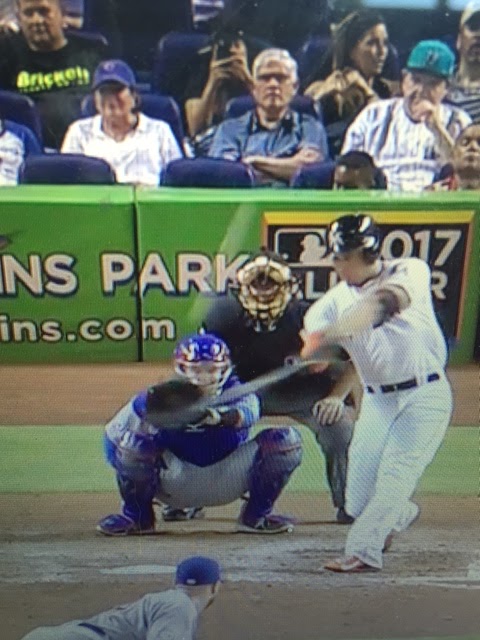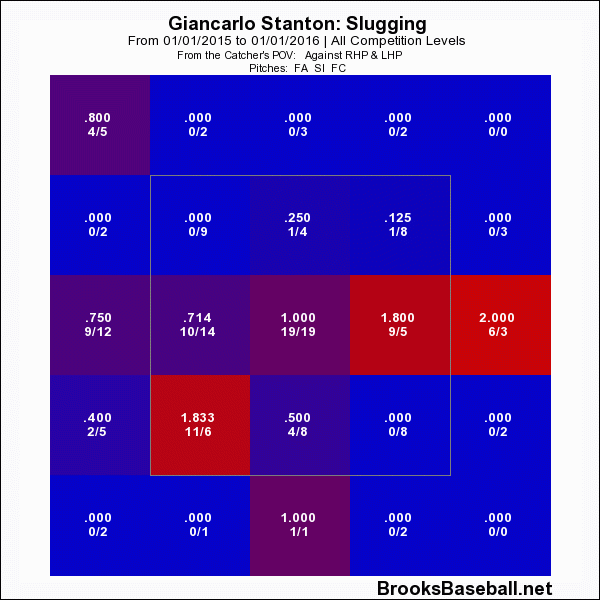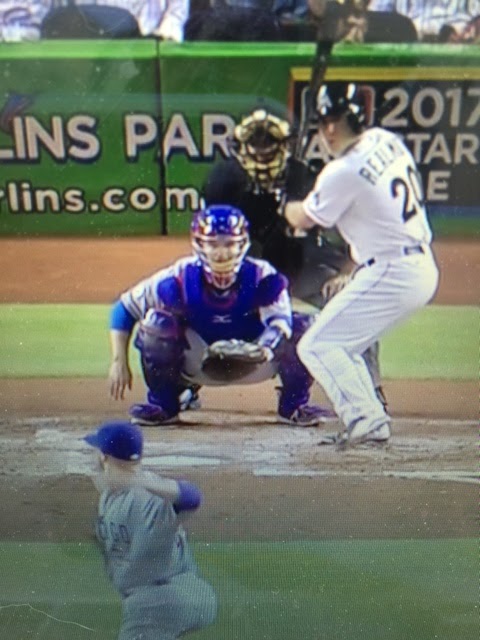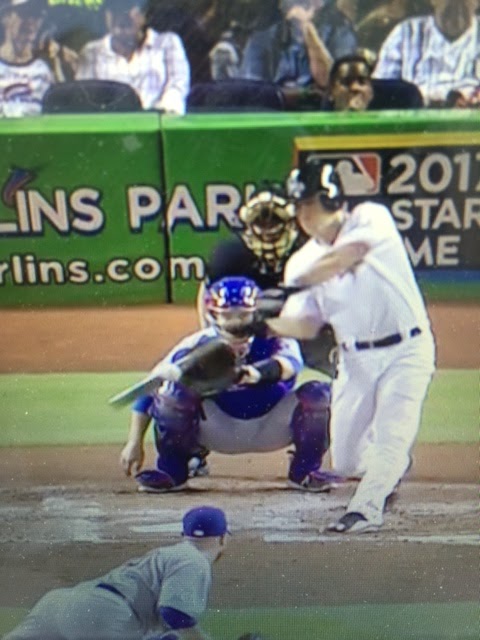Date: June 3
Opponent: Florida Marlins
Location: Marlins Park
Introduction
Jon Lester’s May (1.76 ERA, 1.171 WHIP, .667 opponent’s OPS) was May-gnificant.
(Three second pause while a great silence envelopes the blogosphere)
Good, now that I’ve driven away the rest of the reader(s) who are throwing their computer or iPhone through the nearest window or off the closest national monument, it’s just you and me, dad, left to breakdown Lester’s start against the Miami Marlins.
In Lester’s first June start, the Cubs had their ace on the mound with a chance to win a series for his second consecutive outing. Unfortunately, for the second consecutive start, Lester and the Cubs came up short, undone largely by one bad inning. Lester’s 35-pitch second inning set his season high for pitches in an inning, coming on the heels of his 34-pitch fourth inning against the Nationals. Prior to last week, Lester’s season high for pitches in an inning was 25.
It would be easy to chalk up Lester’s 11th start to a poor second inning, exacerbated by a few bloops, dribblers, and an overturned out call on a run-scoring play. After all, Lester needed just 39 pitches to get through the first, third, and fourth innings. If Chris Coghlan holds on to Ichiro’s fly ball, the entire second inning, and maybe the game, might have played out differently. Or, just a few batters later, if the out call on Dee Gordon is upheld (or if Starlin Castro charged the ball) Lester escapes with just the two earned runs.
There were factors uncontrollable by Lester in Wednesday’s game, absolutely, but much of the damage was self-inflicted. For example, in that second inning, he was missing his spot consistently. As you will see below, Lester had several pitches, mostly fastballs, that were left up and out over the plate:
The fact is, Lester was living dangerously and the Marlins took advantage.
Lester’s ten baserunners allowed matched a season high. For the first time in 2015, Lester allowed two or more earned runs in multiple innings. Lester’s two whiffs on pitches inside the strike zone were his second lowest total of the season, as were his six called strikes on pitches outside the strike zone and three outs recorded on pitches outside the strike zone. Like Cardinals and Reds batters early in the season, Marlins hitters were laying off fastballs away and not missing often when he came back over the plate.
The frustration is amplified, because as we covered after Lester’s last start, it follows two very good performances against the two highest scoring offenses in the National League. After holding the Arizona Diamondbacks and Washington Nationals to three earned runs on 14 strikeout in 14 innings, Lester returned to the land of offensive bottom dwellers.
The Marlins entered the game in the bottom five in the National League in runs scored, on-base percentage, slugging percentage, OPS, and ISO. Of the team’s nine players with at least 125 plate appearances, only four entered Wednesday with a .700 OPS or higher. On Wednesday, they became the first team in 2015 to bat around against Lester.
And speaking of missing with fastballs and great segues, Lester has now surrendered eight home runs in six games, the first time in his career that he has allowed at least one home run in six consecutive games (see Trends section).
Of course, there is no shame in surrendering a home run to Giancarlo Stanton, even when his OPS is more than 60 points below his career average. However, when you leave a 93 mph four-seam fastball up in the zone (again, see Trends), it’s more about failed execution, as opposed to tipping your cap to a great player:
In his last three starts, Lester has taken on the holy triumvirate* of Paul Goldschmidt, Bryce Harper, and Stanton, who have a combined 50 home runs in the first third of the season. Against Lester, they are 4-for-8 with a walk and two home runs.
*The Holy Triumvirate typically refers to the band Rush. And funnily enough, Goldschmidt, Harper, and Stanton do a cover of Tom Sawyer that will blow your mind.
Lester’s start against the Marlins was plagued by poor execution, with some bad luck throw into the mix. Just how did it all go down? Keep reading below find out.
Traditional Line
5.0 IP, 9 H, 4 K, 1 BB, 6 ER
Pitch Breakdown
97 pitches (60 strikes)
| Total | Velocity (Max) | AVG | SLG | BABIP | |
| Four-Seam | 42 | 93.6 (95.4) | .364 | .636 | .333 |
| Cutter | 24 | 90.6 (92.9) | .375 | .625 | .600 |
| Sinker | 12 | 92.7 (94.1) | .000 | .000 | .000 |
| Change-Up | 5 | 87.1 (87.9) | .000 | .000 | .000 |
| Curveball | 14 | 77.0 (78.9) | .667 | 1.667 | .500 |
Lester has now thrown his four-seam and cut fastballs a combined 68.3 percent of all pitches, with opposing batters hitting .292/.348/.497 with eight home runs. The high BABIPs for both the four-seamer (.328) and cutter (.387) suggest this level of production is unsustainable, but right now the damage is being done.
While the cutter has improved since April, as we have covered extensively, Lester and the Cubs are in crisis mode with the four-seamer, as opposing batters are hitting .370/.408/.739 with five home runs in his last five starts (he surrendered nine home runs on the four-seamer in all of 2014). In particular, left-handed batters are hitting four-seamers at .444/.500/1.000. As a reminder, Lester throws the four-seamer more than any other pitch, both in 2015 (41 percent) and his career (39.1percent).
What has been the problem with his go-to pitch? His velocity has remained steady, as has his whiff percentage. So, what’s the problem? For Lester and his fastballs, it is all about location, location, location. When he has hit his spots, his fastballs have been remarkably effective. But when Lester has missed up and out over the plate with his fastball, as he has on eight of the nine home runs surrendered, batters are being very aggressive in 2015:
As you can see, batters are swinging more frequently at Lester’s fastballs in the strike zone than they have in the past:
For just the second time in six starts, Lester’s curveball usage dipped below 15 percent. Jeff Baker’s fifth-inning home run was the first all season Lester has surrendered off the curve. After getting ahead of Baker 0-2 with two curves, Lester and Ross went to it a third time, but it caught just a bit too much of the plate:
It was not a bad pitch selection, as in 2015 Baker already had two strikeouts against curveballs from left-handed pitchers. Like the home runs Lester has surrendered off his fastballs, it was a case of poor execution.
Trends
I will keep it brief, both for my sanity and my dad’s busy schedule.
After Lester’s May 22 start at Arizona, we used the Trends section to analyze the recent home-run barrage against his fastballs. You can click here to see the pitch location breakdown, but we summarized the developing trend in the following way: All home runs had come on four-seam and cut-fastballs up and out over the plate that missed Ross’s target.
The trend continued last week when Lester missed belt high to Harper with a 93.6 mph four-seam fastball, and it continued against the Marlins and Giancarlo Stanton. On 2-1, Ross set-up down and inside:
Lester’s 93 mph four-seamer, however, did not go anywhere near Ross’s mitt:
Stanton lost the belt-high four-seamer deep over the gorgeous lime-pea-aqua green centerfield wall. As you can see below, when pitchers have left fastballs belt high over the middle of the plate, Stanton has not missed:
Again, there is no shame in surrendering a home run to Stanton, or Harper, or Lucas Duda, as Lester has done in his last five starts. It happens to the best pitchers. The frustration comes from Lester missing so badly and consistently with the two pitches he throws with the greatest frequency, both in 2015 and his career. Locating fastballs has gone from a trend to a fairly major issue for Lester and the Cubs.
Key At-Bat/Sequence
Inning: Second Inning
Score: 0-0
Situation: One out, Marcell Ozuna on second base, Ichiro Suzuki on first base
Batter(s): J.T. Realmuto
Let’s take a break from home runs, please.
Lester needed just six pitches to get through the first inning. He then opened the second inning by striking out Baker looking. Lester appeared to be picking up in June right where left off in May. That changed rapidly. Following Marcell Ozuna’s single to center, Ichiro singled to left on a ball that, as we covered at the top, popped out of Coghlan’s glove.
With runners on first and second and one out, catcher J.T. Realmuto stepped to the plate. Realmuto entered the game hitting .208/.237/.333 with a 55 OPS+.
Lester got ahead of Realmuto with a “good get-over curve” as Len Kasper described it, usually a sign that Lester is on top of his game. However, Realmuto battled back to a full count, as Lester worked both sides of the plate with four-seam fastballs. On the 3-2 pitch, Ross set-up low and inside:
Lester, however, strayed back over the plate with a 90 mph cutter:
Realmuto’s ripped double down the left-field line, scoring Ozuna and sending Ichiro to third base, and the floodgates were opened. Lester missed in one of the handful of areas that Realmuto has done damage in his two big-league seasons:
While a 1-0 lead would not be insurmountable, the poor execution in a crucial situation to the number seven hitter wound up being the start of a big inning for the Marlins.
Keep In Mind
Lester had entered the game having thrown 41 innings and, as we mentioned last week, if you remove the runs scored on the six home runs (absurd, I know, but fun), Lester had a 0.22 ERA over the six starts. Lester was bound to have another bad start eventually. True, the Marlins are a middle-of-the-pack offense, even with Stanton, but even poor and average big-league hitters will hit fastballs up in the zone and out over the plate.
Conclusion
Despite his sparkling May numbers, Lester had been living somewhat dangerously, with at least nine baserunners allowed in three of his previous four starts. Though Lester came close a few times in that second inning, you cannot always minimize the damage with so much traffic on the bases. Lester’s four-seam fastball is just hanging over the plate too frequently, and his curveball usage has been down in two of his past three starts. As we know by now, for Lester, effective fastballs and increased trust in his curve go hand-in-hand. One bad start out of seven or eight is a decent ratio, so please, do not drown your sorrows in Redmond’s White Russians…yet.
Season-to-Date
4-4, 3.86 ERA, 1.36 WHIP, 22.2 K%, 6.1 BB%
Next Start
Tuesday, June 9 at Detroit Tigers (Anibal Sanchez)
Photo courtesy of Steve Mitchell-USA TODAY Sports

